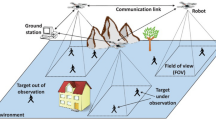Abstract
One approach in swarm robotics is homogeneous system which is embedded with sensing, computing, mobile and communication components. In this study, a target detection problem, which is one of navigation problems, was employed. Once a robot detects a target, robots immediately communicate with a base station via intermediate relay robots due to the multi-hop transmission of wireless communication. Therefore, this control task is completed with connectivity of the network. In a target detection problem, we must improve the performance of exploration as well as connectivity of the network. This study investigates the performances of the two types of random walk algorithm in navigation while loosely ensuring connectivity of the robotic network based on our previous study.









Similar content being viewed by others
Explore related subjects
Discover the latest articles, news and stories from top researchers in related subjects.Notes
Şahin [3] claimed that these criteria should be used as a measure of the degree of SR in a particular study.
We assume that the doors of the rooms are closed during the experiment.
In the reminder of this paper, the robot’s detecting a target is considered to be synonymous with that the base station receives the message from the robot.
References
Trianni V (2008) Evolutionary swarm robotics. Springer
Brambilla M, Ferrante E, Birattari M, Roosevelt AFD, Brambilla M, Ferrante E, Birattari M, Dorigo M (2013) Swarm robotics: a review from the swarm engineering perspective. Swarm Intell 7(1):1–41
Şahin E (2005) Swarm robotics: from sources of inspiration to domains of application. Lecture Notes in Computer Science 3342:10–20
Li J, Andrew LL, Foh CH, Zukerman M, Chen HH (2009) Connectivity, coverage and placement in wireless sensor networks. Sensors 9(10):7664–7693
Ghosha A, Das SK (2008) Coverage and connectivity issues in wireless sensor networks: a survey. Pervasive Mobile Comput 4(3):303–334
Stauffer D, Aharony A (1994) Introduction to percolation theory. CRC Press, Revised second edition
Gilbert EN (1961) Random plane networks. J Soc Indust Appl Math 9(4):533–543
Pike GE, Seager CH (1974) Percolation and conductivity: a computer study. I. Phys Rev B 10(4):1421–1434
Katada Y (2014) Connectivity of swarm robot networks for communication range and the number of robots based on percolation theory. Proceedings of the 2014 IEEE/SICE International Symposium on System Integration 93–98
Viswanathan GM, Afanasyev V, Buldyrev SV, Murphy EJ, Prince PA, Stanley HE (1996) Lévy flight search patterns of wandering albatrosses. Nature 381:413–415
Humphries NE, Weimerskirch H, Queiroz N, Southall EJ, Sims DW (2012) Foraging success of biological Lévy flights recorded in situ. Proc Natl Acad Sci USA 9(19):7169–7174
Lévy P (1937) Theorie de l’addition des veriables aleatoires. Gauthier-Villars
Sutantyo D, Levi P, Möslinger C, Read M (2013) Collective-adaptive Lévy flight for underwater multi-robot exploration. Proceedings of 2013 IEEE International Conference on Mechatronics and Automation 456–462
XBee, Digi International Inc. http://www.digi.com/products/xbee
Robocupjunior soccer rules 2015. http://www.robocupjunior.jp/rule/2014rule/
Koyama H, Namatame A (2008) Comparison of efficiency of random walk based search and Levy flight search. Inf Process Soc Jpn Tech Rep 20:19–24 (in Japanese)
Lee CY, Yao X (2004) Evolutionary programming using mutations based on the Lévy probability distribution. IEEE Trans Evol Comput 8:1–13
Brooks RA (1992) Artificial life and real robots. Proceedings of the First European Conference on Artificial Life 3–10
Jakobi N (1997) Half-baked ad-hoc and noisy: minimal simulation for evolutionary robotics. Proceedings of the Fourth European Conference on Artificial Life 348–357
Miglino O, Lund HH, Nolfi S (1995) Evolving mobile robots in simulated and real environments. Artif Life 2(4):417–434
Keymeulen D, Iwata M, Konaka K, Suzuki R, Kuniyoshi Y, Higuchi T (1998) Off-line model-free and on-line model-based evolution for tracking navigation using evolvable hardware. Springer-Verlag, Proceedings of the First European Workshop on Evolutionary Robotics
Katada, Y, Ohkura, K (2006) An update method of computer simulation for evolutionary robotics. Intell Auton Syst 9 (IAS-9) 357–364
Brooks RA (1986) A robust layered control system for a mobile robot. IEEE Journal of Robotics and Automation 2(1):14–23
Author information
Authors and Affiliations
Corresponding author
Additional information
This work was presented in part at the 1st International Symposium on Swarm Behavior and Bio-Inspired Robotics, Kyoto, Japan, October 28–30, 2015.
About this article
Cite this article
Katada, Y., Nishiguchi, A., Moriwaki, K. et al. Swarm robotic network using Lévy flight in target detection problem. Artif Life Robotics 21, 295–301 (2016). https://doi.org/10.1007/s10015-016-0298-1
Received:
Accepted:
Published:
Issue Date:
DOI: https://doi.org/10.1007/s10015-016-0298-1




